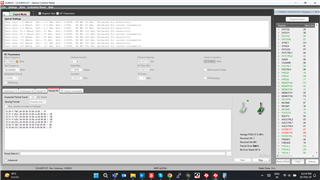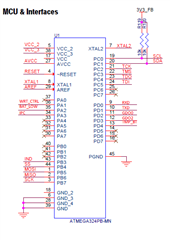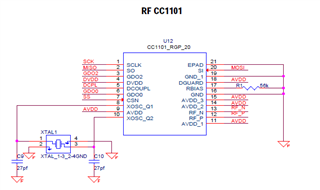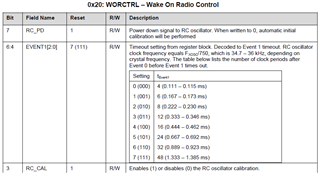Other Parts Discussed in Thread: TEST2
Hello Team,
I am working on a project where I have used a cc1101 chip for RF communication.I am facing an issue, where I can send the data but am not able to receive the data on another cc1101 chip.I am sharing my register configuration and sending and receiving register functionality for reference.
- Register configuration
/CC1101 CONFIG REGSITER #define CC1101_IOCFG2 0x00 // GDO2 output pin configuration #define CC1101_IOCFG1 0x01 // GDO1 output pin configuration #define CC1101_IOCFG0 0x02 // GDO0 output pin configuration #define CC1101_FIFOTHR 0x03 // RX FIFO and TX FIFO thresholds #define CC1101_SYNC1 0x04 // Sync word, high INT8U #define CC1101_SYNC0 0x05 // Sync word, low INT8U #define CC1101_PKTLEN 0x06 // Packet length #define CC1101_PKTCTRL1 0x07 // Packet automation control #define CC1101_PKTCTRL0 0x08 // Packet automation control #define CC1101_ADDR 0x09 // Device address #define CC1101_CHANNR 0x0A // Channel number #define CC1101_FSCTRL1 0x0B // Frequency synthesizer control #define CC1101_FSCTRL0 0x0C // Frequency synthesizer control #define CC1101_FREQ2 0x0D // Frequency control word, high INT8U #define CC1101_FREQ1 0x0E // Frequency control word, middle INT8U #define CC1101_FREQ0 0x0F // Frequency control word, low INT8U #define CC1101_MDMCFG4 0x10 // Modem configuration #define CC1101_MDMCFG3 0x11 // Modem configuration #define CC1101_MDMCFG2 0x12 // Modem configuration #define CC1101_MDMCFG1 0x13 // Modem configuration #define CC1101_MDMCFG0 0x14 // Modem configuration #define CC1101_DEVIATN 0x15 // Modem deviation setting #define CC1101_MCSM2 0x16 // Main Radio Control State Machine configuration #define CC1101_MCSM1 0x17 // Main Radio Control State Machine configuration #define CC1101_MCSM0 0x18 // Main Radio Control State Machine configuration #define CC1101_FOCCFG 0x19 // Frequency Offset Compensation configuration #define CC1101_BSCFG 0x1A // Bit Synchronization configuration #define CC1101_AGCCTRL2 0x1B // AGC control #define CC1101_AGCCTRL1 0x1C // AGC control #define CC1101_AGCCTRL0 0x1D // AGC control #define CC1101_WOREVT1 0x1E // High INT8U Event 0 timeout #define CC1101_WOREVT0 0x1F // Low INT8U Event 0 timeout #define CC1101_WORCTRL 0x20 // Wake On Radio control #define CC1101_FREND1 0x21 // Front end RX configuration #define CC1101_FREND0 0x22 // Front end TX configuration #define CC1101_FSCAL3 0x23 // Frequency synthesizer calibration #define CC1101_FSCAL2 0x24 // Frequency synthesizer calibration #define CC1101_FSCAL1 0x25 // Frequency synthesizer calibration #define CC1101_FSCAL0 0x26 // Frequency synthesizer calibration #define CC1101_RCCTRL1 0x27 // RC oscillator configuration #define CC1101_RCCTRL0 0x28 // RC oscillator configuration #define CC1101_FSTEST 0x29 // Frequency synthesizer calibration control #define CC1101_PTEST 0x2A // Production test #define CC1101_AGCTEST 0x2B // AGC test #define CC1101_TEST2 0x2C // Various test settings #define CC1101_TEST1 0x2D // Various test settings #define CC1101_TEST0 0x2E // Various test settings
- Registers Value
#define VAL_IOCFG2 0x29 #define VAL_IOCFG1 0x2E #define VAL_IOCFG0 0x06 #define VAL_FIFOTHR 0x47 #define VAL_SYNC1 0xD3 #define VAL_SYNC0 0x91 #define VAL_PKTLEN 0xFF #define VAL_PKTCTRL1 0x04 #define VAL_PKTCTRL0 0x05 #define VAL_ADDR 0x00 #define VAL_CHANNR 0x00 #define VAL_FSCTRL1 0x06 #define VAL_FSCTRL0 0x00 #define VAL_FREQ2 0x10 #define VAL_FREQ1 0xA7 #define VAL_FREQ0 0x62 #define VAL_MDMCFG4 0xF5 #define VAL_MDMCFG3 0x83 #define VAL_MDMCFG2 0x13 #define VAL_MDMCFG1 0x22 #define VAL_MDMCFG0 0xF8 #define VAL_DEVIATN 0x15 #define VAL_MCSM2 0x07 #define VAL_MCSM1 0x33//0x3B #define VAL_MCSM0 0x10 #define VAL_FOCCFG 0x16 #define VAL_BSCFG 0x6C #define VAL_AGCCTRL2 0x03 #define VAL_AGCCTRL1 0x40 #define VAL_AGCCTRL0 0x91 #define VAL_WOREVT1 0x80 #define VAL_WOREVT0 0x00 #define VAL_WORCTRL 0xFB #define VAL_FREND1 0x56 #define VAL_FREND0 0x10 #define VAL_FSCAL3 0xE9 #define VAL_FSCAL2 0x2A #define VAL_FSCAL1 0x00 #define VAL_FSCAL0 0x1F #define VAL_FSTEST 0x59 #define VAL_PTEST 0x7F #define VAL_AGCTEST 0x3F #define VAL_TEST2 0x81 #define VAL_TEST1 0x35 #define VAL_TEST0 0x09 #define VAL_PARTNUM 0x00 #define VAL_VERSION 0x06 #define VAL_FREQEST 0x00 #define VAL_LQI 0x00 #define VAL_RSSI 0x00 #define VAL_MARCSTATE 0x00 #define VAL_WORTIME1 0x00 #define VAL_WORTIME0 0x00 #define VAL_PKTSTATUS 0x00 #define VAL_VCO_VC_DAC 0x00 #define VAL_TXBYTES 0x00 #define VAL_RXBYTES 0x00 #define VAL_RF1AIFCTL0 0x00 #define VAL_RF1AIFCTL1 0x00 #define VAL_RF1AIFCTL2 0x00 #define VAL_RF1AIFERR 0x00 #define VAL_RF1AIFERRV 0x00 #define VAL_RF1AIFIV 0x00 #define VAL_RF1AINSTRW 0x00 #define VAL_RF1AINSTR1W 0x00 #define VAL_RF1AINSTR2W 0x00 #define VAL_RF1ADINW 0x00 #define VAL_RF1ASTAT0W 0x00 #define VAL_RF1ASTAT1W 0x00 #define VAL_RF1ASTAT2W 0x00 #define VAL_RF1ADOUT0W 0x00 #define VAL_RF1ADOUT1W 0x00 #define VAL_RF1ADOUT2W 0x00 #define VAL_RF1AIN 0x00 #define VAL_RF1AIFG 0x00 #define VAL_RF1AIES 0x00 #define VAL_RF1AIE 0x00 #define VAL_RF1AIV 0x00 #define VAL_RF1ARXFIFO 0x00 #define VAL_RF1ATXFIFO 0x00
Tx_function() & Rx_function()
tx_fun()
{
SpiWriteReg(CC1101_TXFIFO,size);
SpiWriteBurstReg(CC1101_TXFIFO,txBuffer,size); //write data to send
SpiStrobe(CC1101_STX); //start send
while(!(PIND & (1 <<GDO0 ))); // Wait for GDO0 to be set -> sync transmitted
while((PIND & (1 << GDO0))); // Wait for GDO0 to be cleared -> end of packet
SpiStrobe(CC1101_SFTX); //flush TXfifo
}
rx_func()
{
SpiStrobe(CC1101_SRX);
}








 .
.